Learn how to make this super cultured dairy using lactobacillus reuteri, also known as L. reuteri (pronounced root-awry). This cultured dairy is so abundant in gut-loving good bacteria it can’t be beat. It’s rich, creamy, and thicker than Greek yogurt without the need to strain it. Plus, best of all, it’s tasty too!
This beneficial bacteria doesn’t just colonize in our digestive tract. You can also find it in our urinary tract and our skin, and the bacteria’s benefits can contribute to the health of those areas of our bodies as well.
Affiliates note: As an Amazon Associate I earn from qualifying purchases. My content may contain affiliate links to products and services. If you click through and make a purchase, I’ll receive a small commission. It does not affect the price you pay.
Table of Contents
- Why is L. Reuteri Not Called Yogurt?
- Why Do We Want to Consume L. Reuteri?
- Best Dairy Product to Use with L. reuteri
- Making L. reuteri the First Time
- Making L. reuteri the Second Time
- The Best Prebiotic to Use to Make L. reuteri Cultured Dairy
- How to Maintain the Temperature to Make L. reuteri Cultured Dairy
- Electric Yogurt Makers for Making L. reuteri Cultured Dairy
- Dr. William Davis and L. reuteri
- Who Should Not Eat L. reuteri Cultured Dairy
- The Modern Pioneer Pantry
- More Homemade Dairy Recipes
- Cultures for Health
- Download Your Free 36-Page Pantry List
- The Modern Pioneer Cookbook
- Join the Traditional Foods Kitchen Academy
- Kitchen Academy Videos
- How to Make Super Cultured Dairy with L. reuteri Recipe
- Shop for items used in this blog post or video
Why is L. Reuteri Not Called Yogurt?
You might be wondering why I refer to this recipe as L. reuteri “cultured dairy” and not L. reuteri “yogurt.” Although this cultured diary is indistinguishable from yogurt, it can’t technically be called yogurt, at least not here in the United States. For a cultured dairy product to be called yogurt, the US Food and Drug Administration (FDA) requires that it must contain two specific strains of good bacteria:
- Lactobacillus bulgaricus
- Streptococcus thermophilus
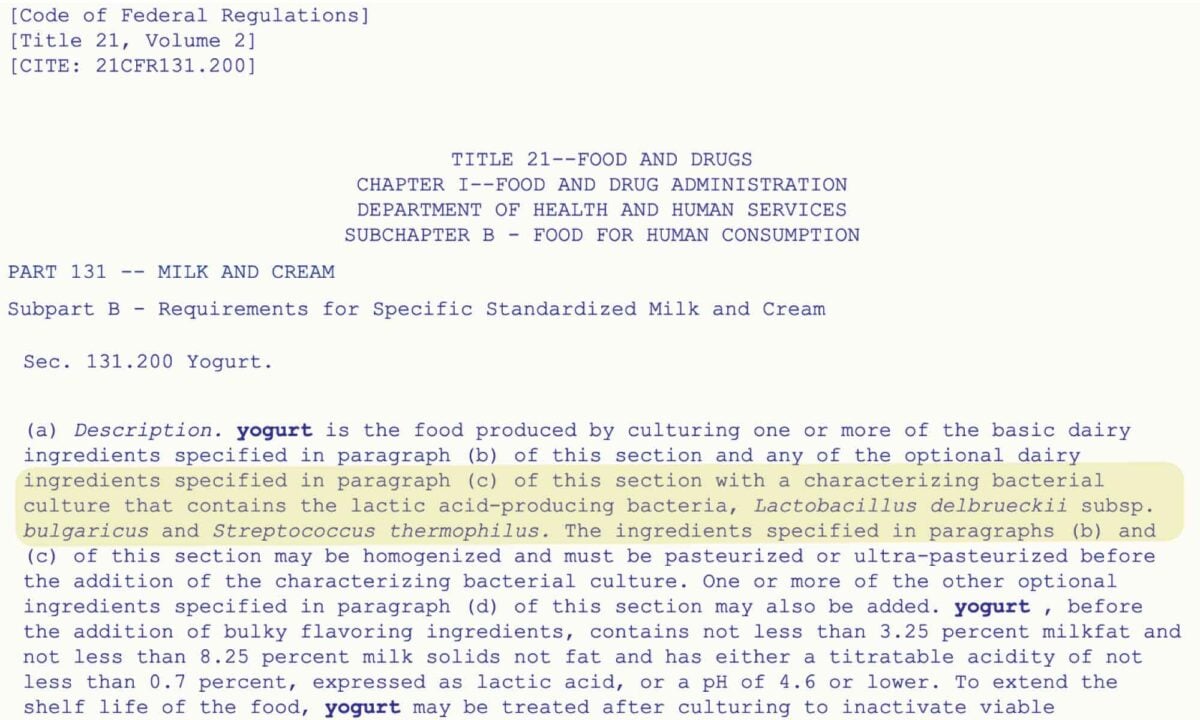
Manufacturers can add additional strains of good bacteria to their product, but these two strains are required to call their product yogurt.
Cultured dairy with L. reuteri is made with only that specific strain of good bacteria and nothing else. So technically, it can’t be called yogurt. But that’s okay. We’ll call it super cultured dairy, and we’ll introduce as much L. reuteri into our diet as possible.
Updates:
- Lactobacillus reuteri was reclassified in 2020 as Limosilactobacillus reuteri, but you may often see it still referred to by its old name.
- Dr. Davis now recommends using one capsule of his new formulation, MyReuteri, for making the perfect probiotic rich cultured dairy, what many devotee refers to as super yogurt!
Why Do We Want to Consume L. Reuteri?
L. reuteri is a good bacteria that used to be plentiful in humans. Unfortunately, the abundance of L. reuteri has decreased in humans in the past few decades, and our modern lifestyle most likely contributed to the decline because of the overuse of antibiotics and the nature of our nutrient-deficient western diet. And that’s a problem!
We want to consume L. reuteri because it may improve our overall health by helping to:
- Tamp down inflammation
- Provide health benefits to our livers and kidneys
- Protect our skin from sun damage
The following scientific articles will help you learn more about this fascinating probiotic and its health-giving benefits:
- Limosilactobacillus reuteri in Health and Disease
- Role of Lactobacillus reuteri in Human Health and Diseases
- The Role of Probiotics in Skin Photoaging and Related Mechanisms: A Review
Note: If you find it difficult to understand research articles, especially when they use terms we are not familiar with, focus on the introduction and conclusion sections since they usually contain a summary of the important elements and findings of the study.
Plus, as described in the following article, L. reuteri might help prevent weight gain and the problems associated with it. More studies need to be conducted in this area, but the recent research is promising.
And as I shared in my video, one of the best things about L. reuteri is that it may give us a boost of oxytocin, which is often nicknamed the love hormone or the cuddle hormone. An increase in oxytocin is supposed to make us more loving, which is certainly a good thing for our mental health. You can learn more in the following article:
Update: For a round up of questions and answers about Super Yogurt, watch my Everything You Ever Wanted to Know about L. Reuteri Super Yogurt video.
Best Dairy Product to Use with L. reuteri
The best way to consume L. reuteri is through a cultured dairy made with half and half. If you prefer, you can use milk, but you will want to only use whole milk (full-fat milk). Alternatively, you can use heavy whipping cream, but the cultured dairy you create will be extremely thick, similar to butter. Overall, half and half will give you the best consistency for your cultured dairy.
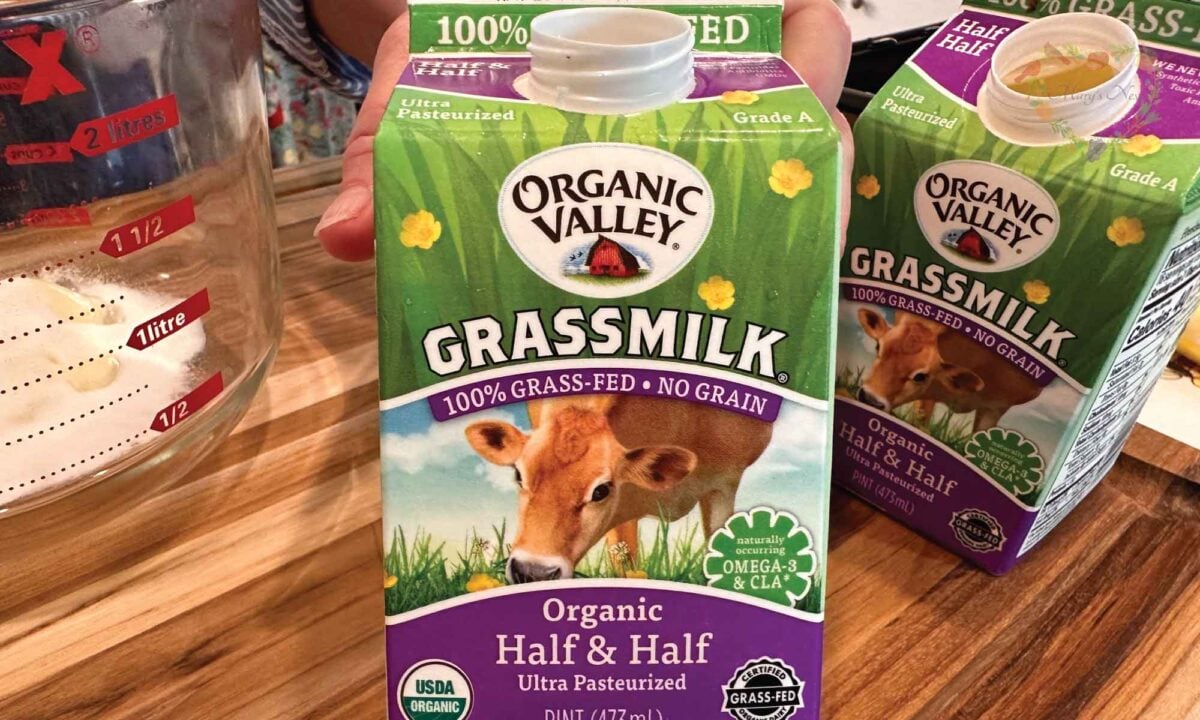
Whatever dairy you decide to use, make sure that it is ultra-pasteurized. This is good news to those of you who have shared with me that ultra-pasteurized dairy products are the only option at your local grocery store.
You want to choose ultra-pasteurized over regular pasteurized dairy because we do not want any other good bacteria that may exist in the dairy to compete with the L. reuteri bacteria we want to culture.
The ultra-pasteurization process heats dairy to 280°F (138°C), essentially killing both the good and bad bacteria that may exist. By making a super cultured dairy with L. reuteri, how amazing is it that we can take a practically sterilized dairy product from the ultra-pasteurization process and turn it into a superfood!
Making L. reuteri the First Time
L. reuteri cultured dairy is quite easy to make. It takes time, but the time is on the part of the good bacteria as it cultures. Your part only takes a few minutes. The first time you make this recipe, you’ll introduce L. reuteri into the recipe from tablets and create your super cultured dairy with the following steps:
- Crush the L. reuteri tablets. (Update: Dr. Davis now recommends using one capsule of his new formulation, MyReuteri, for making this recipe.)
- Mix the crushed tablets with a bit of prebiotic food (inulin).
- Pour in a bit of dairy half and half to make a slurry.
- Once everything is smooth and well combined, pour in the remaining half and half.
- Culture the mixture for 36 hours between 97°F to 100°F (36°- 38°C).
- Enjoy immediately or refrigerate and enjoy once cold.
Using Crushed L. reuteri Tablets to Culture Dairy
It’s important to note that your first batch of L. reuteri cultured dairy will look different than all your future batches. In the first batch, you used the crushed L. reuteri tablets to introduce this good bacteria into your recipe.
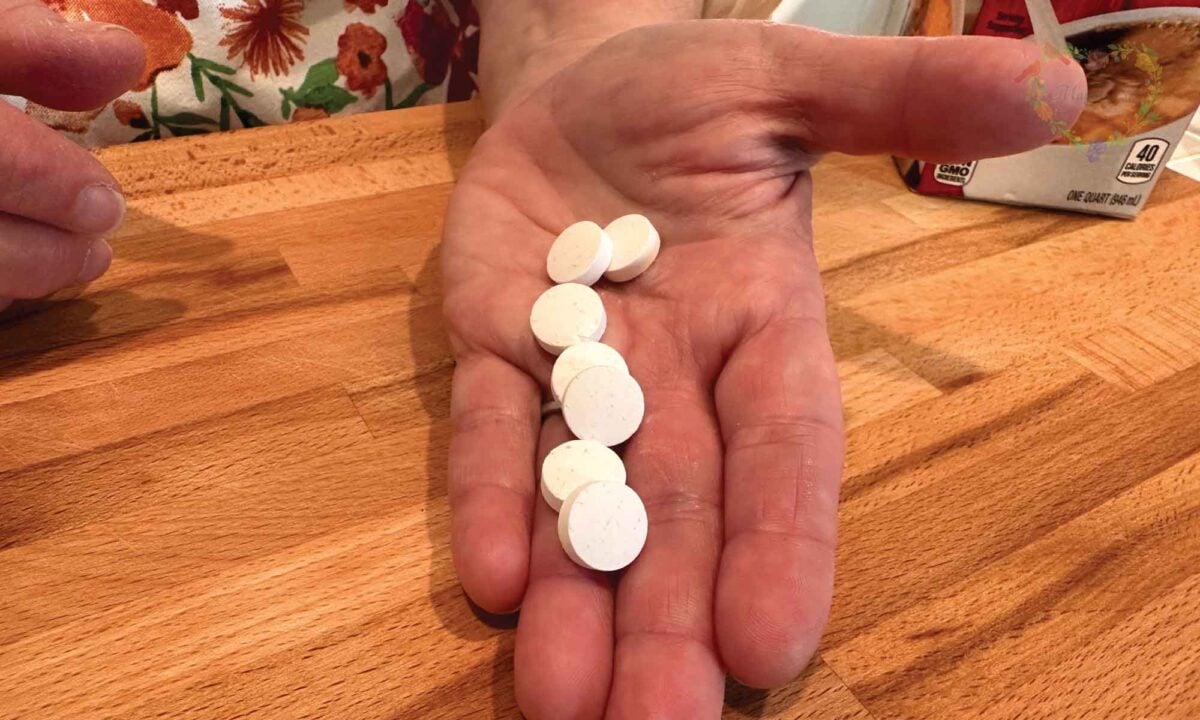
The super cultured dairy you produce from this first batch will display a bit of a curdled or curds and whey characteristic. However, you can easily rectify this by stirring it all back together with a spoon.
Update: Dr. Davis now recommends using one capsule of his new formulation, MyReuteri, for making this recipe.
Making L. reuteri the Second Time
When you make your second batch of L. reuteri cultured dairy, you will not need to use the crushed tablets again. Instead, you will use some of the actual cultured dairy that you made with your first batch to introduce the good bacteria into your recipe.
From then on, you can make every subsequent batch of L. reuteri cultured dairy with some of the cultured dairy from your previous batch. You only need the tablets for the initial batch.
As you can see from the following steps, only the step where you introduce your good bacteria is different:
- Start with 2 tbsps from your previous L. reuteri cultured dairy.
- Mix the 2 tbsps of cultured dairy with a bit of prebiotic food (inulin).
- Pour in a bit of dairy half and half to make a slurry.
- Once everything is smooth and well combined, pour in the remaining half and half.
- Culture the mixture for 36 hours between 97°F to 100°F (36°- 38°C).
- Enjoy immediately or refrigerate and enjoy once cold.
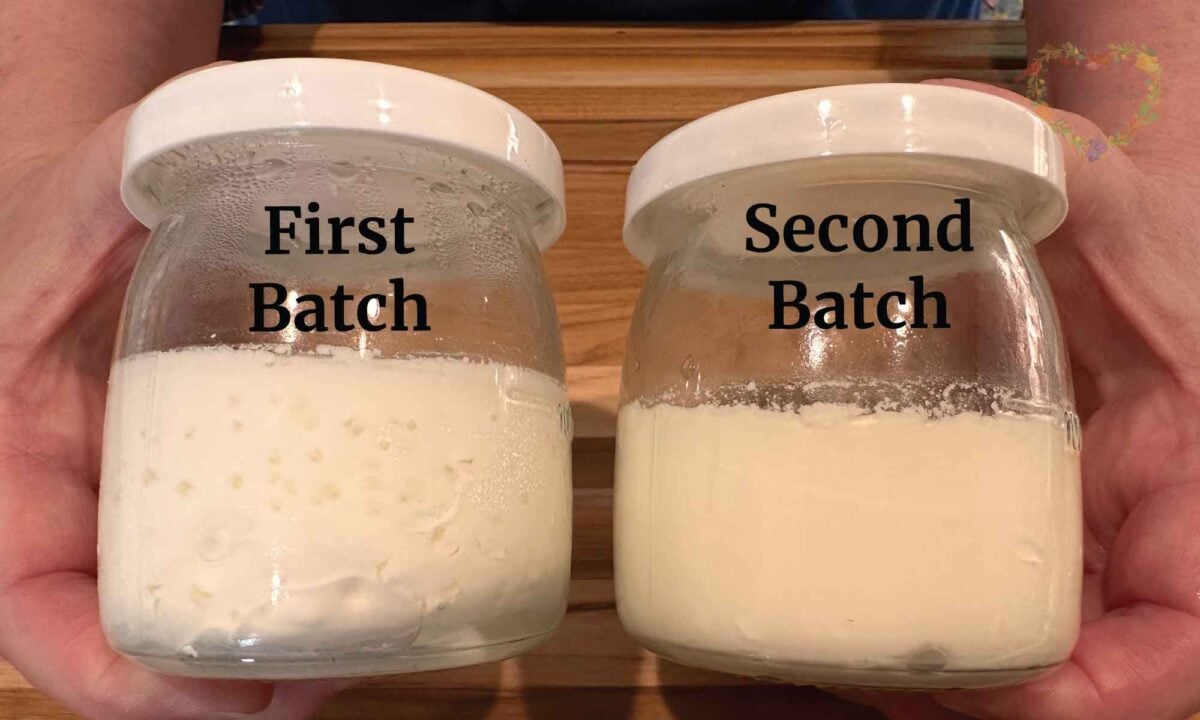
The Best Prebiotic to Use to Make L. reuteri Cultured Dairy
When it comes to providing the probiotics (the good bacteria) with a source of food, you will need a prebiotic in addition to the dairy you use. The prebiotic will give your probiotic food to multiply during the culturing process. Your prebiotic should be in the form of what is known as inulin. Inulin is a form of a prebiotic fiber—a starchy substance—and is found in the following foods:
- Fruits, including bananas
- Herbs, including chicory
- Onions and leeks
- Vegetables, including asparagus and Jerusalem artichokes
- Wheat (in smaller amounts)
Inulin is usually sold in a powder form, with the most common options coming from chicory and Jerusalem artichokes.
Using a Combination Prebiotic the First Time
Initially, when I made my first batch of L. reuteri cultured dairy, I used a product called Prebio Plus with the following listed ingredients:
- Inulin – The packaging listed inulin as a generic term, but it did not specify the variety.
- Acacia – This ingredient is another form of fiber used as a prebiotic.
- Fructooligosaccharides (FOS) – FOS is a carbohydrate that is also used as a prebiotic.
When I used this combination prebiotic, I noticed it may not have dissolved completely in my cultured dairy and created small bead-like clumps. Was this due to the fact that this was the first batch in which the curdling effect also occurred?
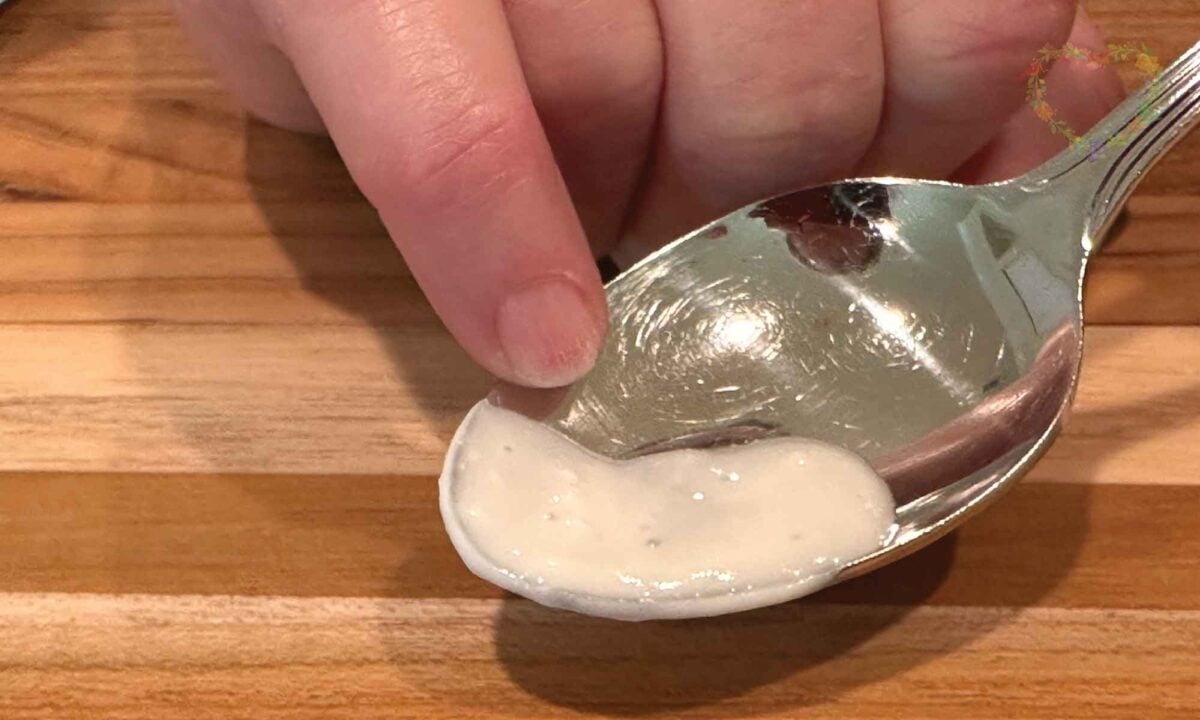
Making Additional Batches
I decided to make three additional batches (Batches 2 -4) of the L. reuteri cultured dairy. Altogether, I made the following four batches:
- Batch 1 made with Prebio Plus (Described earlier.)
- Batch 2 made with Chicory inulin
- Batch 3 made with Jerusalem artichoke inulin
- Batch 4 made with Prebio Plus (This is the same inulin I used in the first batch.)
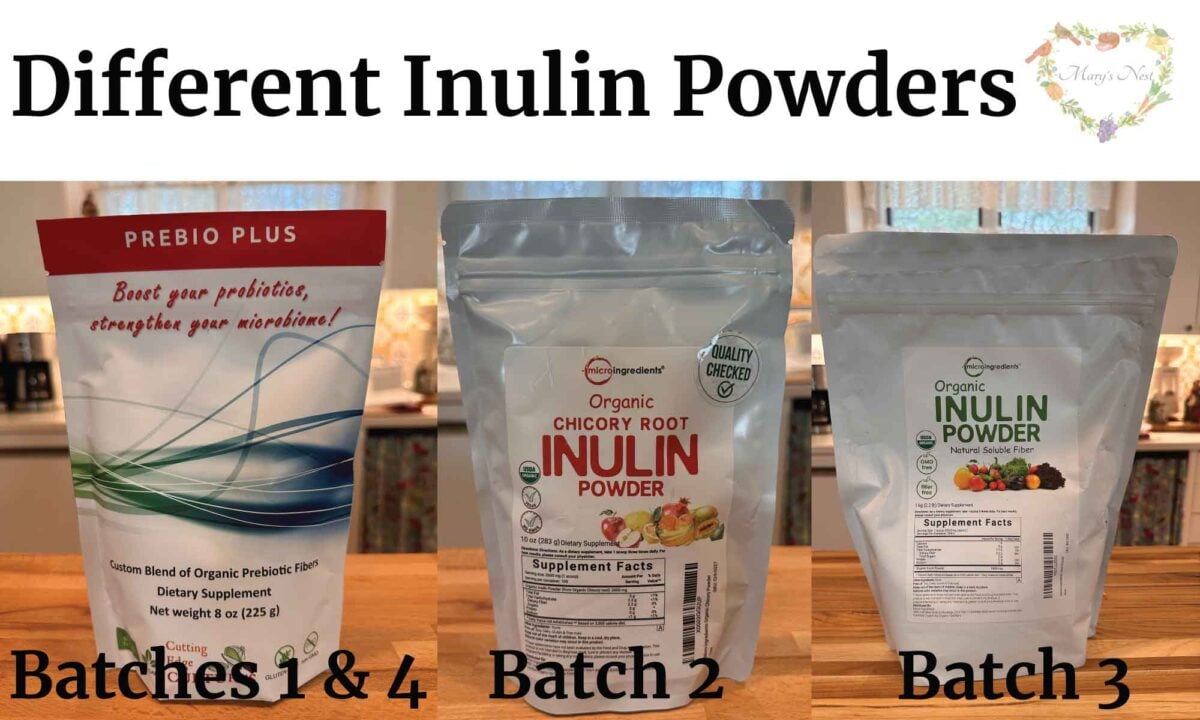
Each of the subsequent batches of L. reuteri cultured dairy (after the first one) was made without using the L. reuteri tablets. Instead, I made them using some of my previous batch L. reuteri cultured dairy.
The good news is that each subsequent batch of L. reuteri, in which various forms of inulin were used, did not contain any small clumping. Instead, each batch was very smooth in consistency and texture similar to a very thick Greek yogurt.
Thus, I found that you can use whatever inulin you like as the prebiotic because you’re using a previous batch of L. reuteri cultured dairy. The tablets in the first batch likely caused the separation into curds and whey, which you can quickly remedy by mixing the entire contents.
Here’s how rich, smooth, and creamy the second batch of L. reuteri cultured dairy looks.
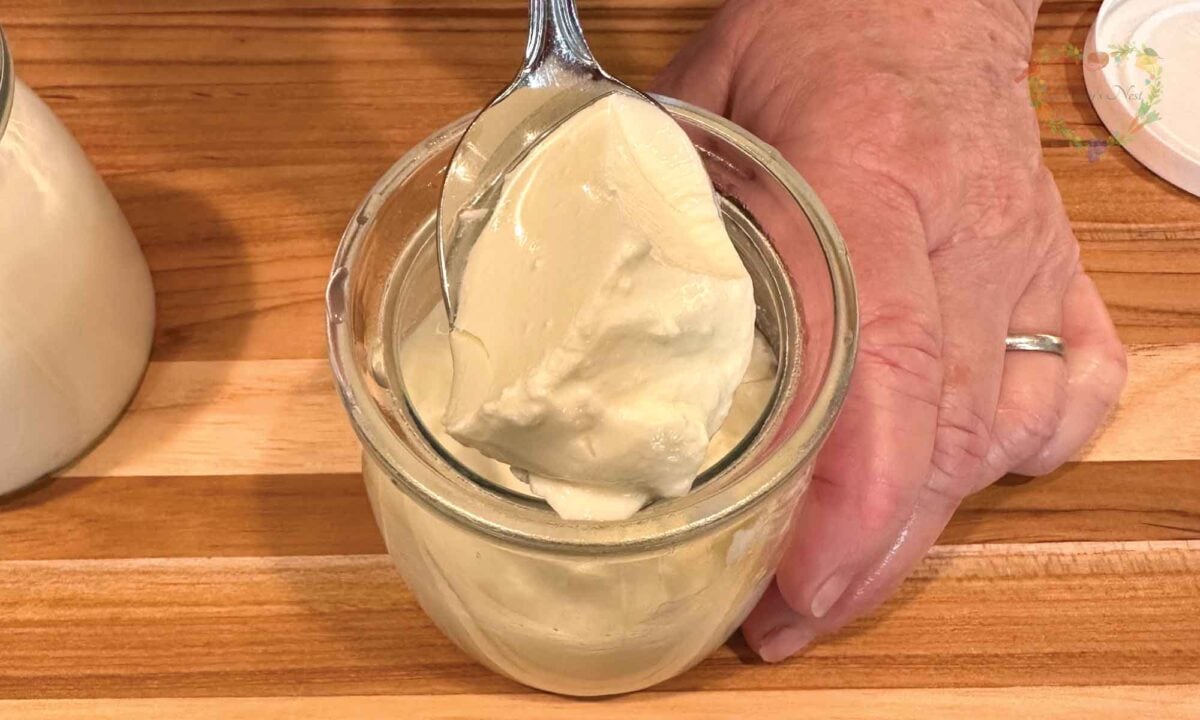
How to Maintain the Temperature to Make L. reuteri Cultured Dairy
You have a number of options when it comes to maintaining a temperature between 97°F to 100°F (36°- 38°C) to make L. reuteri cultured dairy. Any of the following appliances will work:
- Electric Yogurt Maker with programable temperature controls
- Instant Pot with programable temperature controls (Watch my How to Make Super Cultured Dairy with L. Reuteri in the Instant Pot video.)
- Sous Vide
If you do not have any of these appliances, you can also try using an electric oven, turned off, with or without the electric light on. You will want to use an oven thermometer to determine what the internal temperature of your oven is initially and then make adjustments to the temperature either by:
- Adding a bowl of warm water (which you change out periodically), or
- Determining if the oven light should be on or off.
Electric Yogurt Makers for Making L. reuteri Cultured Dairy
I used two different electric yogurt makers to make L. reuteri cultured dairy.
LynTorin Yogurt Maker
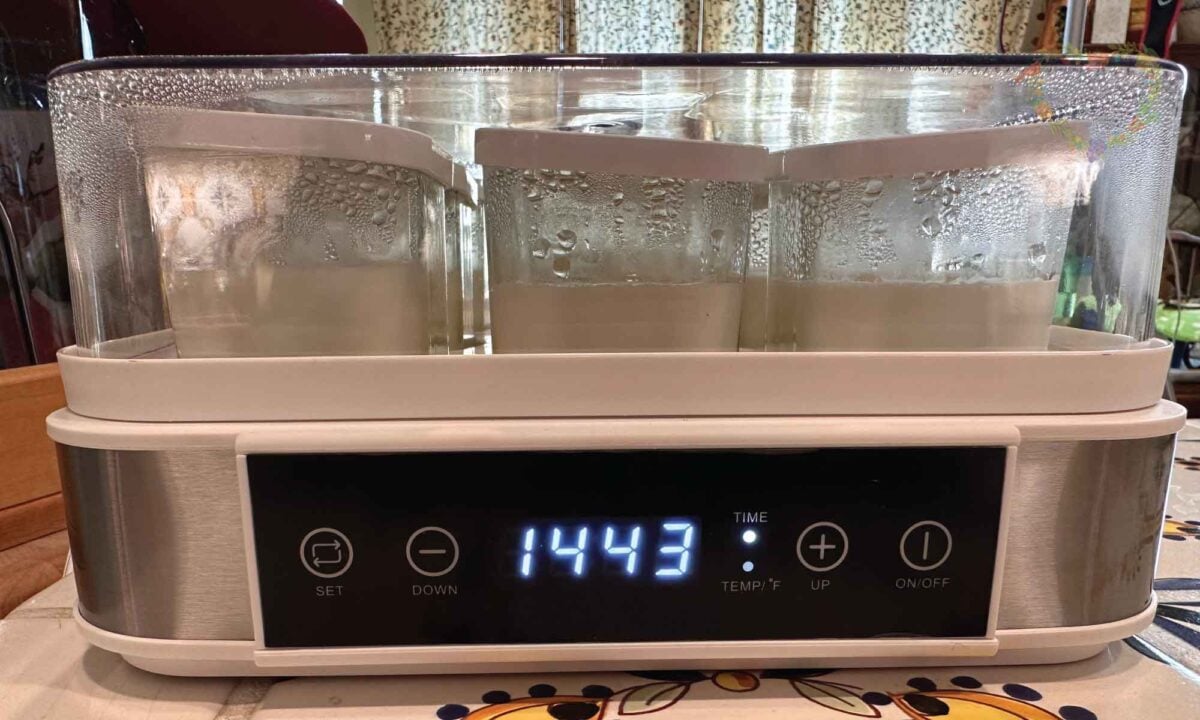
The LynTorin Yogurt Maker is excellent if you want to know the exact time left needed to make your cultured dairy. It allows you to set the temperature and the time and then counts down both the hours and the minutes.
For me, the only drawback about this model is the square jars that it uses. They store easier in the fridge, but I found them more difficult to eat out of. Removing the cultured dairy from the corners of a square jar is more cumbersome than when eating out of a round jar.
Suteck Yogurt Maker
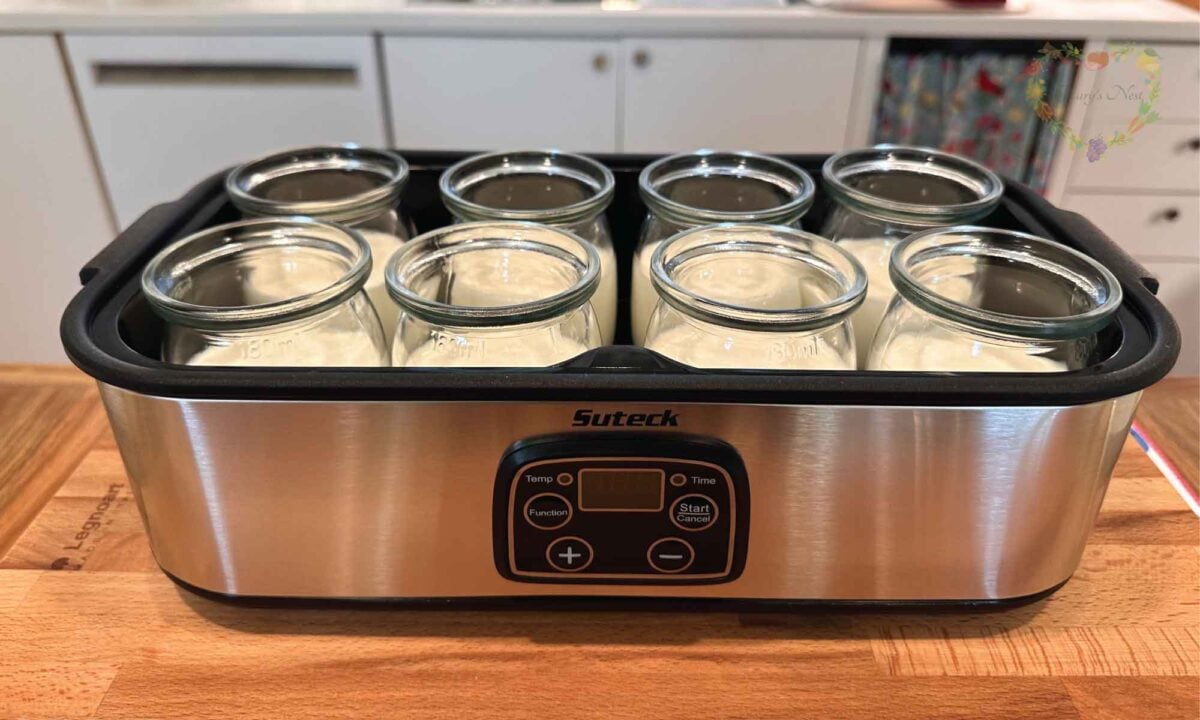
However, it’s much easier to eat the cultured dairy from the round jars that come with the yogurt maker. At the time of this writing, the price point on this yogurt maker is less expensive than the LynTorin brand, yet it performed equally as well.
Dr. William Davis and L. reuteri
If you have read the Wheat Belly series of books, then the name Dr. William Davis will already be familiar to you. But did you know Dr. Davis has a new book titled Super Gut? This book is one of the best I have read on gut health, and part of the book focuses on the importance of making L. reuteri cultured dairy.
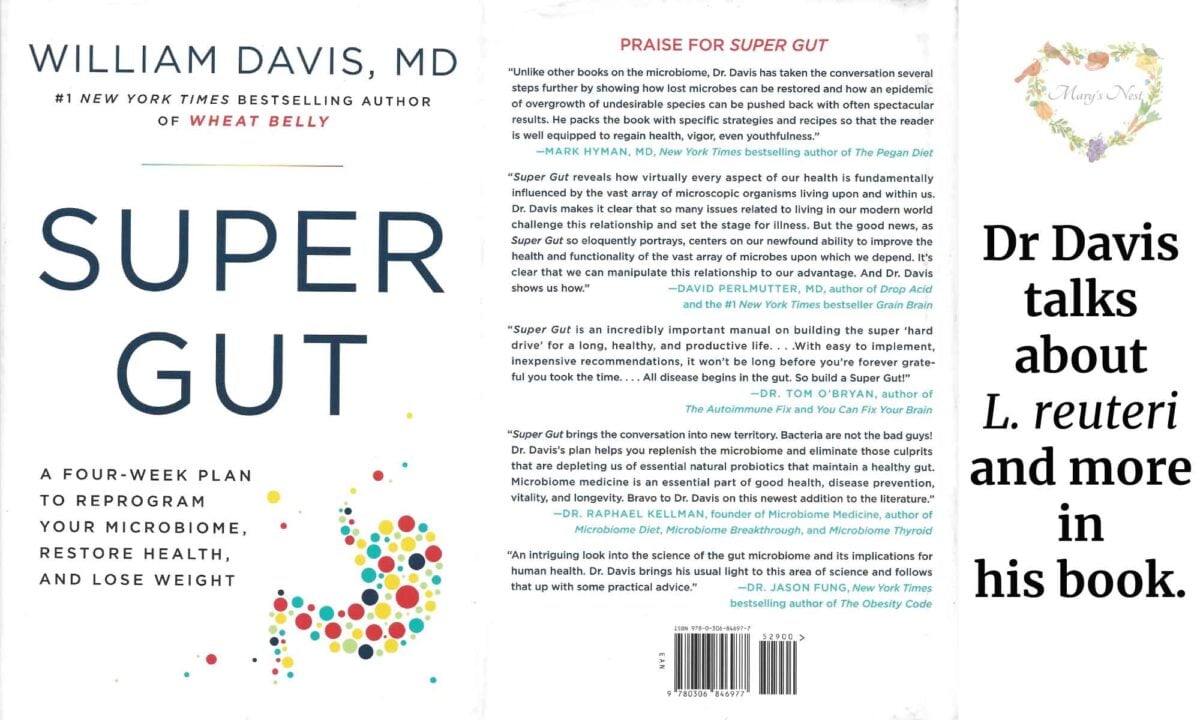
Dr. Davis determined the importance of the long culturing time to maximize the amount of L. reuteri. As we culture dairy—any dairy—good bacteria grows and develops. But it isn’t until the 30-hour mark that the good bacteria (the probiotic) really takes off and begins to increase significantly. At the 36-hour mark, the L. reuteri peaks considerably. Hence, when we culture dairy, specifically L. reuteri, we want to culture it for 36 hours.
I highly recommend reading Dr. Davis’ book Super-Gut if you are interested in learning more about L. reuteri, as well as other strains of probiotics, and how to culture them appropriately for maximum strength.
Additional Resources
In addition to Dr. Davis’ book, I recommend Both of Donna Schwenk’s books that dive deeper into culturing topics:
And be sure to visit Donna’s website, where you can learn more about her YouTube channel and podcast.
Who Should Not Eat L. reuteri Cultured Dairy
Not everyone should rush out and start making and eating L. reuteri cultured dairy. As always, if you are pregnant, nursing, or thinking of feeding this to children, be sure to speak with your healthcare practitioner first.
Also, since L. reuteri may be associated with stimulating the immune system, if you have an auto-immune disease or have a related illness, you will want to check with your healthcare practitioner to determine if this type of cultured dairy would be appropriate for you to consume, or if it is best avoided.
Disclaimer
I am not a doctor or medical professional. If you are not feeling well, please seek professional medical attention and medicine. And if you are thinking of supplementing your treatment with home remedies, be sure to talk to your medical professional about them. It’s important that you get the medicine and treatments you need to get back to good health.

preOrder YOUR COPY Now!
The Modern Pioneer Pantry
Simple ingredients, timeless techniques, and a well-stocked pantry. Discover over 100 nourishing recipes to preserve food and turn pantry staples into delicious, homemade meals. Build a wholesome, traditional pantry—just like a modern pioneer!
More Homemade Dairy Recipes
If you’d like to make more homemade dairy recipes, I’ll show you how to make cultured butter, clotted cream, cream cheese, and more in your own kitchen.
- How to Make Cultured Butter with Only 2 Ingredients
- How to Make English Clotted Cream
- How to Make Cream Cheese with Just One Ingredient
And if you’d like to make homemade yogurt, I’ll show you a recipe for how to make it without needing a special machine.
Cultures for Health
If you would like to try your hand at making other types of cultured dairy, as well as homemade cheeses, be sure to check out the starter cultures from Cultures for Health. They offer an extensive line of cultures for making homemade cultured and fermented foods. And if you order from their website, be sure to use my MARYSNEST discount code for 15% off your purchase.

- Cultures for Health – Make Real Cultured Foods at Home and use discount code MARYSNEST for 15% off your purchase on the Cultures for Health website.
- Cultures for Health on Amazon
Download Your Free 36-Page Pantry List
For an extensive list of the traditional foods you can make and purchase to stock your pantry, be sure to download my free 36-page Traditional Foods Pantry List. This comprehensive eBook is full of links to recipe videos, helpful articles, and more!
And if you’re looking for a printed book full of my traditional foods recipes that shows you how to create a traditional foods kitchen, be sure to order your copy of my new book, The Modern Pioneer Cookbook.
Join the Traditional Foods Kitchen Academy
Are you looking for more traditional foods videos? If so, I invite you to join the Traditional Foods Kitchen Academy. Members of this optional paid YouTube community get access to exclusive videos and other members-only perks. Plus, your YouTube comments include a special members-only badge.
In the following replay of my members-only live stream, I talk about my L. reuteri cultured dairy experience.
Kitchen Academy Videos
The Only Traditional Recipes You’ll Ever Need!
Focus on traditional recipes with real food. Don’t chase trends.
Let’s Talk Akkermansia: A Tiny Helper for Big Gut Health
Discover how Akkermansia muciniphila supports gut and immune health—and how traditional foods help this mighty microbe thrive.
How to Eat a Mediterranean Diet with a Keto Twist
Explore a Mediterranean-Keto twist with a full sample menu focused on healthy fats, quality proteins, and low-carb veggies.
Stay in Touch with Mary’s Nest
- Subscribe to My YouTube Channel for Traditional Foods Videos (Free) - When you subscribe, be sure to click on the notification bell that will let you know each time I upload a new video.
- Subscribe to Mary’s Traditional Foods Newsletter (Free) - Get a free 36-page eBook for signing up: How to Stock Your Essential Traditional Foods Four-Corners Pantry.
- Join the Traditional Foods Kitchen Academy - For more detailed videos and exclusive members-only perks, join my YouTube membership community.
- Order The Modern Pioneer Cookbook - Get a hardcover book of Mary's nourishing recipes from a Traditional Foods Kitchen. This bestselling cookbook is published by Penguin Random House with their DK imprint.
- Preorder The Modern Pioneer Pantry - Be one of the first to get Mary's hardcover book about preserving food and making delicious meals from your Four Corners Pantry. Mary's second cookbook is also published by Penguin Random House.
I look forward to having you join me in my Texas Hill Country Kitchen!
I’d like to receive more tips and recipes from Mary’s Nest.
How to Make Super Cultured Dairy with L. reuteri

Equipment
- 1 Yogurt maker, Instant Pot, or Sous Vide Able to maintain a temperature of 100°F (38°C) for 36 hours
Ingredients
- 10 tablets L. reuteri You will only need the tablets the first time you make this recipe. For subsequent batches, you can use 2 tbsps of your previously made L. reuteri cultured dairy.
- 2 tbsp Inulin This is a powdered form of a prebiotic fiber, including chicory or Jerusalem artichoke.
- 32 ounces Ultra-pasteurized half and half Alternatively, you can use whole milk or heavy whipping cream. Do not use non-fat or low-fat milk.
Instructions
- Crush the L. reuteri tablets in a clean plastic bag using the flat side of a meat mallet or a rolling pin. Alternatively, you can crush the tablets in a clean mortar and pestle.
- To a large bowl, add the powder of the crushed tablets and the inulin along with a small amount of the half and half. Whisk well to make a slurry.
- Add the remaining half and half to the slurry and whisk well.
- Depending on what type of appliance you are using, the half and half mixture can remain in the bowl, be transferred to smaller yogurt jars, or placed into the liner of an Instant Pot. If using a sous vide, the bowl can be placed into a second bowl filled with water that is sufficient in size to accommodate the sous vide.
- Culture the half and half mixture for 36 hours at 100° F (38°C).
- When finished culturing, transfer the cultured dairy to the refrigerator. It will stay fresh with active probiotics for 10 days.
Video
Notes
Nutrition
Shop for items used in this blog post or video
Favorite Cultured Dairy Supplies
- L. Reuteri tablets (Update: Dr. Davis now recommends using one capsule of his new formulation, MyReuteri, for making this recipe.)
- Prebio Plus
- Jerusalem artichoke inulin
- Chicory inulin
- LynTorin Yogurt Maker
- Suteck Yogurt Maker
- 8-cup glass measuring cup
- Measuring spoons
- Magic whisk
Amazon Shop and Shopping Guide
- Visit Mary’s Nest Amazon Shop
- Visit my Shopping Guide page
Get up to 15% off for stocking your Traditional Foods Pantry and equipping your Modern Pioneer Kitchen, including discounts from US Wellness Meats, Farmhouse Teas, Lehman's, Masontops, Cultures for Health, Survival Garden Seeds, Redmond Real Salt, Plan to Eat, and More!
Recommended Reading
- The Modern Pioneer Cookbook
- The Modern Pioneer Pantry
- Super Gut
- Cultured Food for Life
- Cultured Food for Health
- Homemade Yogurt & Kefir
- Nourishing Traditions
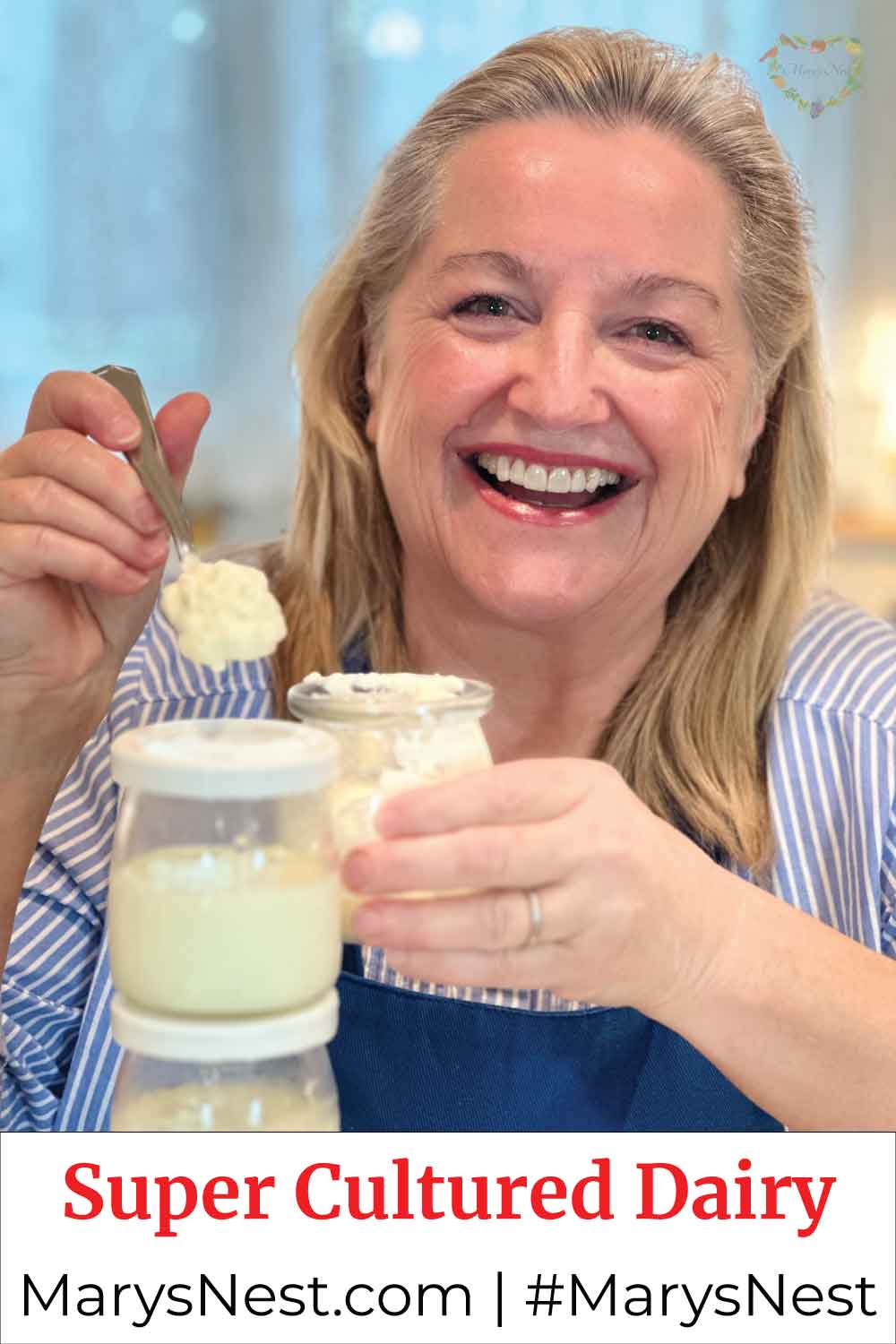
Disclaimer:I am not a medical doctor, a medical professional, a dietician, or a nutritionist. All content found on the MarysNest.com website, including text, images, videos, eBooks or eGuides, social media, or other formats, were created solely for informational purposes only. The content is not intended to be a substitute for professional medical advice, diagnosis, or treatment. Always seek the advice of your physician or other qualified healthcare provider with any questions you may have regarding a medical condition or proper nutritional advice. Never disregard professional medical advice or delay in seeking it because of something you have watched in a video or read on this website. Use caution when following the recipe in this video. The creator and publisher of this video and website will not be held responsible for any adverse effects that may arise from the use of this recipe and method or any other recipe and method on this website or corresponding video channel.


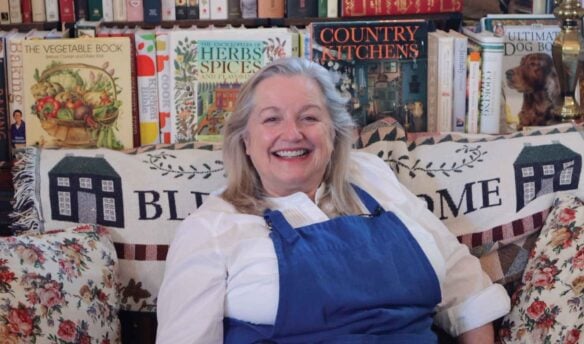




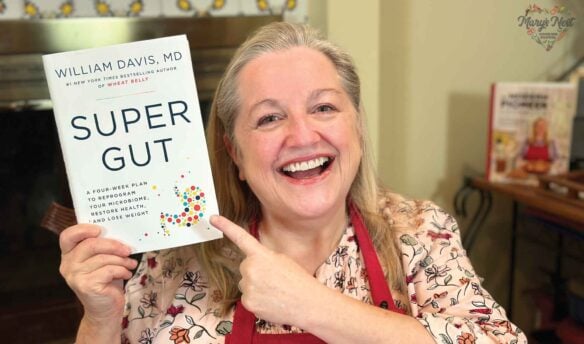
Mary, I live in Asia and can only get the lactobacillus reuteri in powder form. can you tell me the total grams of the tables you used, so I can measure properly? Thanks!! Love you dear girl, and so appreciate you are on you tube for us.
Hi Randy,
Thanks for your comment. One tablet weighs 0.6 grams.
I hope this helps and that your “Super Yogurt” turns out great!
Love and God bless,
Mary
I love making this!!! I have the yogurt maker on my wish list, but in the meantime, I am using a crockpot on the “keep warm” setting, with a dish towel on the bottom. I keep the lid on partially and a thermometer in the center to monitor the temperature of the water around the jelly jars full of this beautiful dairy. It works! Thank you for sharing. I cannot wait until I get the cookbook!!!
Hi Kathy,
Thanks so much for sharing how you make L. Reuteri in your crockpot. Your wonderful details will help other sweet friends too!
Love and God bless,
Mary
Thank you so much for this recipe! My first batch smelled really strong, maybe because my timing was off and the 36 hours ended in the middle of the night. But the second batch is perfect and so good!
I’ve been making a cold start yogurt with half and half for years and use my dehydrator to keep the temperature and time exactly where I want them. Works great and gives my dehydrator something to do when I’m not dehydrating fruits and veggies.
Hi Karen,
I’m glad your second batch turned out wonderfully, and thank you for sharing how you use your dehydrator for making cold start yogurt. That will help other sweet friends too!
Love and God bless,
Mary
Hi, can I start with half a quart (half the qty) since the first patch will not be as good in consistency?
Hi Gehan,
Thanks for your comment. You can try, but I would recommend that you go ahead and make the full recipe. Remember that you can always mix the curds and whey that may develop in your first batch and enjoy the result as you wait for your “perfect” second batch.
Love and God bless,
Mary
Hi Mary, what a joy to stumble across one of your videos on YouTube and now I’m a fan 🙂 I’m attempting this recipe in my instant pot but I tripled the recipe and I’m not sure if that was a good idea. I’m at almost 24 hours and the half and half just barely has a skim on the top; otherwise, it hasn’t thickened up whatsoever (I did invest in a very nice yogurt maker with temperature control, but it won’t be here until May). Any thoughts on this first attempt? Thanks so much!
Hi Jenn,
Thanks for your comment. Wow! You were very enthusiastic about making a triple batch! Was your half and half ultra-pasteurized? And did you triple all the ingredients to 6 tablespoons of inulin and 30 crushed L. Reuteri tablets? If not, this may be contributing to the problem. You might be able to get away with just the 10 tablets, but I think you would have definitely needed to triple the inulin. But don’t worry. It should thicken up somewhat after 36 hours and then even more so once refrigerated.
Love and God bless,
Mary
I watched your video on L Reuteri and tried a batch. I realized after it was culturing that I used pasteurized half and half instead of ultra pasteurized. I can set my oven to 100 degrees and after 24 hours it was separated and looked like over fermented kefir. I checked the temp of the culture and it was 102 degrees. I turned the oven down to 95 and checked again and it was 98 degrees. Did I totally mess it up? Can it still be used for subsequent batches or do I need to start all over?
Hi Suzanna,
I haven’t tried making L. Reuteri in the oven, but don’t worry. Mix the curds and whey together and refrigerate them. You can eat it. And then, use 2 tablespoons of that batch to make your next batch.
Thanks for your comment.
Love and God bless,
Mary
I make both water and milk kefir. Can you share what the main difference is between Cultured Dairy an Kefir? Is the gut health benefit better if eating cultured Dairy?
Hoping you have an answer for me!
Thank you – and Have the best day!
Hi Jillian,
Great question! Yes, the L. Reuteri cultured dairy is potentially stronger than the milk kefir because the cultured dairy is cultured for 36 hours. The milk kefir from the store is most likely only cultured for 4 hours. That said, if you make homemade kefir, it will be stronger than the store-bought, but in terms of the specific beneficial bacteria – L. Reuteri – the cultured dairy will be stronger.
Thanks for your comment.
Love and God bless,
Mary
Found this also (no tablet crushing required, is “unflavored” — and perhaps it will eliminate the first batch clotting issues):
https://www.amazon.com/SuperFood-ProBiotic-Recommended-Cultured-Lactobacillus/dp/B09V1VK7W8
Hi Kay,
Thanks for your comment and for letting us know about this product. (If another sweet friend tries this powder instead of using the crushed-up tablets, please let us know how it works for you.)
Love and God bless,
Mary
Hi, Sweet friend Mary! Do you know if you can culture coconut milk with l. Reuteri? Unfortunately I don’t tolerate milk. :- (
Thank you!
Hi Cathleen,
Yes, you can, and I will make a video about it once I perfect it, so stay tuned! 😉
Thanks for your comment.
Love and God bless,
Mary
Hello! Love this post! We also made the Reuteri “yogurt” for a time. I have two instant pots, and found that if I used my six quart on the “yogurt” setting, my yogurt cultured at around 94 degrees, perfect for Reuteri, as opposed to the yogurt setting on the 8 quart pot, which was more like 110 degrees. I stopped using the inulin, or any additives, because I found it didn’t really need it.
I grew to prefer the taste of the Reuteri to any other yogurt, but ultimately had to stop making it because it was definitely a weight gainer for me. Alas, I am one of those people who gains weight on dairy no matter how I try to justify it in my diet or how little I eat. There is also some evidence via studies that some of us have Insulin spikes on dairy fat that don’t seem to be caused by high blood sugar. In other words, even when eating cream or other very low-sugar dairies, there is no obvious cause and effect, but still it causes an insulin release. I know that I have higher insulin and gain weight when dairy is a regular addition to my diet, and I never eat uncultured dairy or anything less than half fat. If I take dairy out of my diet for a few months and get tested, my insulin goes down. It’s a very clear path for me in that respect.
For those who tolerate dairy, this is a game-changer flavor wise and I hope people try it!
Hi Ann,
Thank you so much for this wonderful comment and sharing so much valuable information! I am happy that we are on this traditional foods journey together! Love, Mary
I find sometimes the inulin clumps. And hard to whisk in the slurry. Also I’ve had it twice the yogurt has a very sour, almost spoiled taste. Other times nice and sweet. Any ideas for solutions?
Hi Margaret,
Thanks so much for your comment. So sorry to hear about the problems you have run into. First, let’s discuss the inulin. Are you using room temperature half and half? And are you whisking for at least 30 to 60 seconds?
Next, as to taste, everyone’s pallet is different. First, make sure that you are culturing the L. Reuteri at 100°F for 36 hours. If you still find the taste to be sour, you can sweeten your “Super Yogurt” with any type of liquid whole sweetener like honey or maple syrup.
I hope this helps you.
Love and God bless,
Mary
Great. It does seem to leave people much more pleasant with daily usuage.
Hi Linda, That is great to hear. I really hope so. We could use a little more pleasantries in our world today! Love, Mary